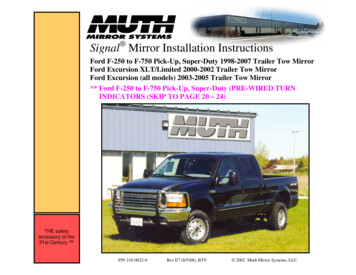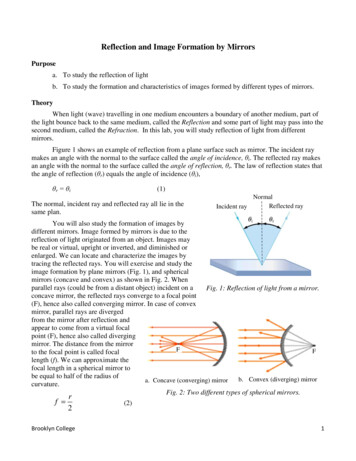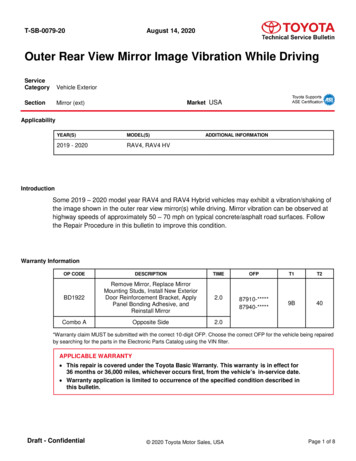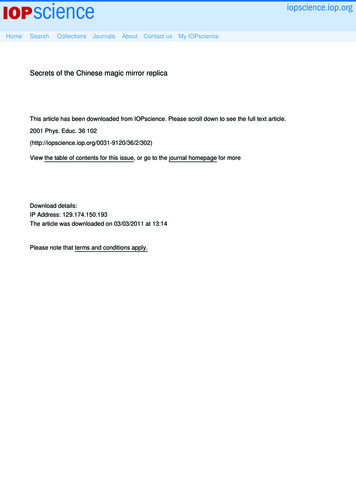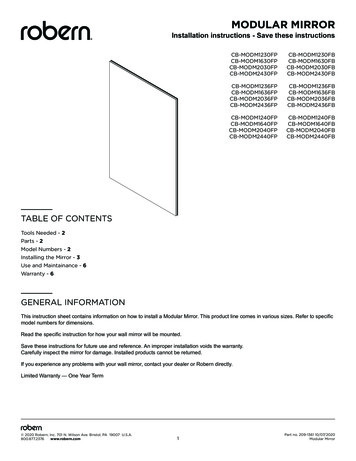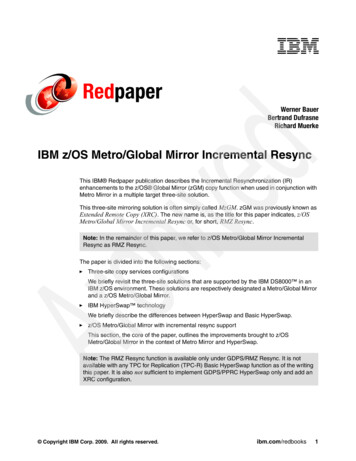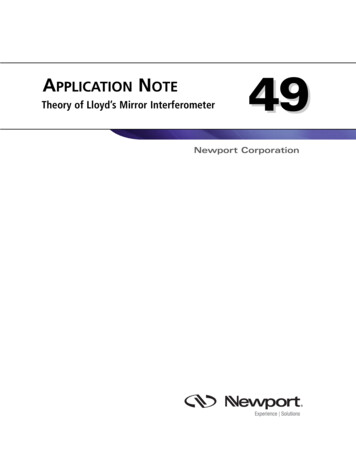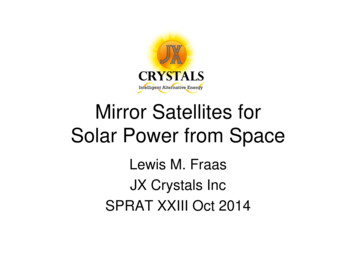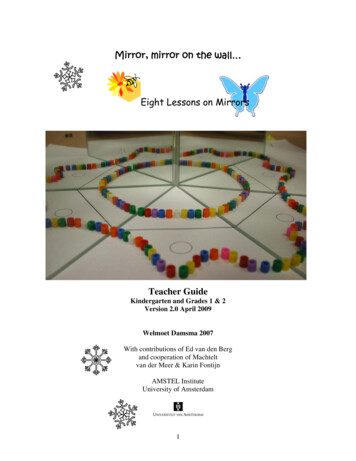
Transcription
Mirror, mirror on the wall Eight Lessons on MirrorsTeacher GuideKindergarten and Grades 1 & 2Version 2.0 April 2009Welmoet Damsma 2007With contributions of Ed van den Bergand cooperation of Machteltvan der Meer & Karin FontijnAMSTEL InstituteUniversity of Amsterdam1
PrefaceThis lesson series was developed by Welmoet Damsma for use in her thesis project for theMasters of Mathematics and Science Education program of the AMSTEL Institute of theUniversity of Amsterdam. The module was tried out in two iterative cycles with Kindergarten andgrade 1 & 2 students of elementary school De Nieuwe Kring in Diemen. The module wastranslated and edited for the European POLLEN project by Ed van den Berg who also contributedto the background section. Paul Hewitt graciously granted permission to use several illustrationsfrom his Conceptual Physics in the background section.POLLEN 2006 – 2009 is a European project for the promotion of inquiry learning inelementary science education. The project takes place in 12 cities in 12 countriesincluding Amsterdam. POLLEN is English for seeds: the POLLEN project wants to sawseeds across education and society. The core ideas of POLLEN are: Active participation of children through hands-on and minds-on inquiry learning.Participation of society.In each of the participating cities it is expected that POLLEN partners support inquiry learning inscience through: In-service teacher education Materials and services for hands-on/minds on inquiry learning Advice and other support for science educationIn Amsterdam we do this through in-service courses on inquiry (science) and design (technology)and guiding implementation in the classroom. We also assist schools in developing their ownscience and technology programs.In the Amsterdam POLLEN project the following partners cooperate: the AMSTEL Institute ofthe University of Amsterdam, the Hogeschool of Amsterdam, and the VTB network Amsterdam.Further information about the AMSTEL Institute can be found cfmInformation on the POLLEN project is on:http://www.pollen-europa.net Welmoet Damsma and AMSTEL Institute, Amsterdam 2007Creative commons copyright:You are free: to Share — to copy, distribute, display, and perform the workUnder the following conditions: Attribution. You must attribute the work in the manner specified by the author or licensor (butnot in any way that suggests that they endorse you or your use of the work).Noncommercial. You may not use this work for commercial purposes.For any reuse or distribution, you must make clear to others the license terms of this work. Thebest way to do this is with a link to this web page.Any of the above conditions can be waived if you get permission from the copyright holder.Apart from the remix rights granted under this license, nothing in this license impairs or restrictsthe author's moral rights.2
Table of ContentsMirror, mirror on the wall . 1Preface. 2Table of Contents. 3The Magic Mirror . 4Background Information. 51. History of mirrors . 52. Two kinds of reflection. 54. How do we see? . 75. Special mirrors . 86. Symmetry. 9Mirrors: Potential Learning Outcomes . 10Lesson 1: Discover the Mirror . 13Lesson 2: Discovering more mirrors. 15Lesson 3: The Magic Mirror . 17Lesson 4: The double mirror. 20Lesson 5: Reflection . 23Lesson 6: Symmetry . 25Lesson 7. Walking the lines (Kindergarten) . 27Lesson 7: Symmetry in letters (Grades 1 & 2) . 28Lesson 8: The Periscope . 30Other Lessons: What else is possible? . 32Worksheets (separate 9.20.21.22.Cover of mirror notebookDiscover the mirrorMore mirrorsDouble mirror – line and dotDouble mirror – own drawingSymmetry - generalSymmetry - heartSymmetry – snow flakeSymmetry - circleSymmetry – butterflySymmetry extra – ice bear3Symmetry extra – airplaneSymmetry extra – boatSymmetry extra - umbrellaColoring Symmetry 1Coloring Symmetry 2Symmetry letters – explanationSymmetry letters – letter diagramsSymmetry letters – making wordsSymmetry letters – making more wordsPeriscope frontPeriscope back
The Magic MirrorPurpose: To encourage interest in science phenomena among children age 4 - 8 To explore, observe, and name the properties of mirrors and mirror phenomenathrough investigation To practice communication skills by communicating observations and“discoveries” to the groupLevel: Version A: Kindergarten, age 4-6Version B: Grades 1&2, age 6-8, but extendable to higher ages (this version)Number of lessons: 8, each lesson takes about 45 minutes but most lessons can be madeto last anywhere from 35 – 75 minutesThe module consists of a Science kit with a Teacher GuideMaterials in the science kit per class:1 big mirror for teacher demo25 mirror tiles25 double mirror tilesChristmas ballsGlittering starsExample magic mirror (students make their own)Templates for magic mirrorsExample disco ballMini-disco ballsFlashlightGlittering stuffColored beadsSpoonsWorksheets (with drawings only, no text):Double mirror: line and dotDouble mirror: triangleDouble mirror: squareDouble mirror: pentagonSymmetry: complete treeSymmetry: half a tree (1)Symmetry: half a tree (2)Symmetry: half a tree (3)Symmetry: half a tree (4)4
Background InformationThis is a short introduction for the teacher. Actually, the mirror lessons do not requiremuch background knowledge but we do recommend you read this section. Please notethat the information is NOT for the pupils.1. History of mirrors (http://en.wikipedia.org/wiki/Mirror)Figure 1: Roman mirrormade of bronze. Someparts are still mirroringa bit. First century AD.People have seen their mirror image for a long time in dark poolsof water, rivers and lakes. Mirroring was considered some kindof magic. Over 2000 years ago Egyptians, Greeks, and theRomans made mirrors of pieces of polished metal, usually silverand sometimes bronze. Glass was discovered by the Phoeniciansaround 5000 BC but only during the Roman times people inSidon (Lebanon) made the first glass mirrors by putting somemetal at the back of glass.Glass blowing was discovered during Roman times but only inthe 12th and 13th century AD a glass industry developed inVenice and Southern Germany/Bohemia. Mirrors were producedtoo, but they were very expensive. Therefore the mirrors in thepalace of Versailles were very special and a sign of opulentwealth and power. From the 17th century mirrors were used moreand more as decoration. Starting in the 19th century mirrorsbecame much cheaper thanks to new technology and entered thehouses of common people. Nowadays the metal at the back ofmirrors usually is a thin layer of aluminum.2. Two kinds of reflectionWhen you shine light from a laser pen or flashlight on the ceiling, everybody in the roomcan see the light spot on the ceiling. This means that the light rays of the flashlight whichare coming from one direction, are reflected or “scattered” by the ceiling in all directionsand enter the pupils of the eyes of all present. This is called diffuse reflection (Figure 2b,3b). Diffuse reflection occurs with all objects around us except for shiny objects likemirrors.When you shine the light from a laser pen or a narrow and parallel beam of light from aflashlight onto a mirror (please try the set up of figure 31), then quite surprisingly onedoes not see a light spot on the mirror. The light beam is reflected in a particular directionand can only be seen in that direction. This is called specular reflection but with childrenwe just call it mirror reflection (Figure 2a and 3a). Mirrors have a very smooth surface.In figure 3a we caught this reflection on a piece of paper. On the other hand, when weshine the light of a laser pen on paper, the light spot can be seen from all directions(figure 3b).1Safety: never look directly into a laser beam or (mirror) reflections of it. Looking at diffuse reflections oflaser beams on paper or on the wall is okay as then the laser rays and energy are scattered.5
Figure 2Figure 3a Mirror reflection: The laser pointer is directedat the mirror. However, looking from the side we do notsee a lighted spot on the mirror. All the laser light isreflected in one direction only, towards the white paperscreen. On the screen we see a light spot as the screenreflects the light diffusely to all directions including thedirection of the cameraFigure 3b Diffuse reflection: De laser pointer isdirected towards the white paper screen. Fromthere the light is reflected in all directions includingthe direction of the camera. So the light spot isvisible from all sides.The light of the flashlight in figure 4 hits the disco balland is then (mirror) reflected towards the paper. Thepaper reflects the light diffusely. The light spots on thepaper can be seen from all directions. How are lightrays reflected by a mirror?Mirrors reflect light according to physics rules. Whenyou shine with a flashlight on a mirror, you will see alight spot of reflected light on the ceiling or on the wall.When you move the flashlight, the light spot will move.The dashed line perpendicular to the mirror is called theFigure 4: Example of mirrornormal line, it is an imaginary line. With that line wereflection from the disco ball andcan define an angle of incidence and an angle ofdiffuse reflection .from the paper.reflection (figure 5). In mirror reflection these anglesare equal. We can predict where the incident light raywill go after reflection. Diffuse reflection also follows this rule, but due to the roughnessof the surface, the light rays are reflected in all directions (Figure 2b).6
Figure 5Angle of incidence equalsangle of reflectionWhen you shine with a laserpointer or with a torch on a mirror,Figure 6mirrorthe light reflects and forms a spoton a screen (the wall, or a piece ofpaper). Using the mirror law, wecan exactly predict where the lightnormalspot will be. What will happenwhen you hold a second mirror inthe beam of reflected rays? Infigure 7 you see a light beamMirror law:mirrorreflected by two mirrors accordingAngle of incidence angle ofreflectionto the law “angle of incidence normalangle of reflection”. You can useas many mirrors as you want, but it works best in a darkened room. Put a cylinder ofpaper around the torch so that the light beam does not diverge. DO NOT let childrenhandle a laser pointer.4. How do we see?For seeing we need light. Light-rays have to enter our eyes. Light rays from the Sun orfrom lamps hit objects and are then scattered in all directions. In Figure 7 light rays fromthe Sun hit a book. The light is scattered in all directions, including the direction of theeyes of Lisa. Light rays from all parts of the book form an image on the retina of Lisa’seyes.7
Figure 7: Light raysfrom the Sun arescattered in alldirections by thebook. Light rays hitall parts of the book.Some light raysfrom each part ofthe book arescattered in thedirection of Lisa’seyes and form animage on the retinaof her eyes.5. Special mirrorsAll kinds of shiny objects act like mirrors: Christmas balls, spoons, pans, windows,computer screens. A lake with clear water and a dark bottom mirrors very well when thesurface is flat (no wind). Similarly transparent plastic mirrors reasonably well when puton top of dark paper (lesson 3). Transparent plastic on a light colored piece of paper doesnot mirror well. With a dark piece of paper as background the transparent plastic reflectssome light while the light that goes through it gets absorbed by the dark colored paper.However, with the light colored paper much light is reflected by the paper and competeswith the light reflected from the mirror. As the reflection on the paper is diffuse, it cannotgenerate a mirror image.Some mirrors have a curved surface (figure 8). A Christmas ball distorts your mirrorimage. The ball is a convex mirror. A metal waste basket can also act as a convex mirrorjust like the outside of a spoon. There are also concave mirrors such as the inside of aspoon. Laughing mirrors consist of convex and concave parts which distort the image infunny ways.Figure 8: Reflection from a convex mirror (left) and from a concave mirror (right). For each light raywe can apply the rule that angle of incidence is the angle of reflection. These angles are measured froma line perpendicular to the surface of the mirror (the normal line). However at every point thisperpendicular line has a different orientation.8
Figure 9a. Reflection in a convex mirror (like the outside of a spoon). The image is smaller than the originaland upright.b. Reflection in a concave mirror (such as the inside of a spoon). The image is larger than the original.It is upright when the object is very near the mirror (within the focal length) and inverted when it isfarther than the focal length. On the inside of a spoon the image usually is inverted, unless the spoon isvery big and our face is very near.6. SymmetryThere are many kinds of symmetry. In the lessons we will be looking at mirror symmetry.That means that we are looking whether two sides separated by a line are equal. The twoparts should be each other’s mirror image. One can check by placing a mirror on that lineand the one side of the figure its mirror image should look like the original picturewithout the mirror. The line is called an axis of symmetry. It separates the picture intotwo equal halves.Figure 11: The star has several axes of symmetry:Figure 10: The head of the tiger is symmetricwith respect to a vertical line in the middle ofthe nose. It is not symmetric with respect to ahorizontal line through the mouth oranywhere else through the face.etc.9
Mirrors: Potential Learning OutcomesAll activities:Attitude: interest and curiosity with regard to mirrors (and that will succeed!), observingand describing objectively, critical attitude.Lesson 1: Discover the mirrorLanguage: mirror, reflection, describing experience in words and gestures, listening.Concepts: mirroringSkills: describing and demonstrating observations and discoveries orally to other studentsin the circle.Inquiry: Exploring, describingLesson 2: Discovering more mirrorsLanguage: reflection, mirroring, sparking, names of shiny/mirroring materials such asglass, metals, plastic.Concepts: recognizing mirroring en not-mirroring objects in the environmentSkills: classifying of mirroring versus not mirroring objects/materials and writingobservations in a table (Grades 1&2). Tracing light rays being reflected such as sun lightfrom water or from a watch and creating light spots on the classroom ceiling includinglightrays from multiple mirrors.Inquiry: exploringLesson 3: The Magic MirrorLanguage: absorption, reflectionConcepts: absorption, reflection, dark color paper absorbs much light en reflects little,light colored paper reflects much light.Inquiry: Predicting and trying out which color paper forms the best background for amirror using an OHP transparency, concluding and finding out that your preferred coloris not necessarily the best one for a mirror (multiple criteria).10
Lesson 4: Double mirrorLanguage: describing observations in words and gestures (that is quite complex in thisactivity but it works very well).Mathematics: line, triangle, square, circle, spatial skills in making art products with thedouble mirror.Concepts: multiple reflections between two mirrors can generate many images,difference between left and right in the reflections.Skills: using mirrors to make art products, colors,Inquiry: exploring, investigating relationship between angle and number of images,concluding, presenting.Lesson 5: ReflectionLanguage: Light ray, reflection, reflected rayConcepts: light rays, light beam (of torch), law of reflection (intuitively, getting a feelingfor where you should look to find the reflected rays)Mathematics: spatial insight, this becomes more complex with multiple reflections butkids are able, representing incident and reflected light rays in a diagram (not all kids cando this).Skill: manipulating mirrors, tracing light beams, directing mirrors, improvising areflecting disco ball.Inquiry/Design: relationship of incident and reflected light rays, designing and executingan experiment, designing or just copying a disco ball.Lesson 6: SymmetryLanguage: Symmetric, asymmetric, horizontal, vertical, horizontal symmetry, verticalsymmetry, axis of symmetry.Concepts: symmetry, axis of symmetry, mirroring, left-right inversion (vertical axis),top-down inversion (horizontal axis)Skill: manipulating the mirrorMathematics: spatial insight, predicting/anticipating of results of mirroring (will thereflection result in a symmetrical figure or not?).Inquiry: predicting and testing of symmetriesLesson 7 (Kindergarten): Walking the lineLanguage: mirroring, left and rightConcepts: mirroring, left and rightMathematics: Spatial skills, consistently being able to switch left and right such asturning left when the mirror indicates right.Skills: coordination of vision in mirror and stepping in the right direction11
Les 7 (grades 1&2): Symmetry in lettersLanguage Symmetric, asymmetric, horizontal, vertical, horizontal symmetry, verticalsymmetry, axis of symmetry; symmetry in letters, mirroring of letters and words,assembling words with vertical or horizontal symmetry.Concepts: symmetry, axis of symmetry, mirroring, left-right inversion (vertical axis),top-down inversion (horizontal axis)Skill: manipulating the mirrorMathematics: spatial insight, predicting/anticipating of results of mirroring (will thereflection result in the same letter or not?)Inquiry/design: Predicting and testing of symmetriesLeson 8: PeriscopeLanguage: periscopeConcepts: periscope, reflecting with two mirrors, understanding the behavior of lightrays in a periscope.Skills: converting a two dimensional predrawn structure into a 3-dimensional object,cutting, folding, pasting, attaching mirrorsMathematics: spatial insight in the working of a periscopeInquiry/Design: trouble shooting when construction is difficult or mirrors are not in theproper position12
Lesson 1: Discover the MirrorEverybody must have looked into a mirror, but have youplayed with it? In this lesson we will first look what wecan do with a mirror.Needed/Preparation:- Big mirror- Mirror for every child- Optional worksheet 2 (to be copied)Lesson descriptionPlenary1. Spread the mirror tiles across a table. When the students enter,they will be interested right away.2. The class starts with all the kids sitting in a big circle, as is custom inthe lower grades in the Netherlands.3. Take the big mirror. What is this? What can you see? Later the kids will gettheir own mirror. Alternatively (and better):start with a story about a mirror.Individually4. All students get their own mirror tile and areallowed to walk around for a few minutes todiscover things.Plenary5. Students tell what they discovered. Wesuggest that you let other kids “copy” the discovery by trying it with theirown mirror. For example, if one child reports that she can use the mirror tolook behind her, let others try to position their mirrors such that they canlook behind them also. The copying itself is an exercise in communicatingthrough language and gestures!Individually6. It is possible to do another round of walking around and discovering. Thechildren often get more ideas the second time around. They also like to walkaround.13
ExtensionsYou could ask the children to fill worksheet 2 to describe/sketch their discoveries.14
Lesson 2: Discovering more mirrorsApart from “real mirrors”, many objects exhibit mirror effects, for exampleChristmas balls, spoons, pots and pans, CDs.Needed/preparation:- One box per group children- Per box mirror objects such as christmas balls (are included in the kit), smallstars, boxes, pieces of aluminum foil, metal teapot, metal scissors, CD boxes,top of a pan *- Per box non-mirroring objects such as pieces of paper, cork, pencils, rubberbands, plastic beaker,etc.- Possibly worksheet #3, one per child.* Not all boxes need to have the same content.Lesson descriptionPlenary:1. What did we do last time?2. There are other things that are like mirrors. Doyou see some in the classroom? What do you see? The children can look around to see.Often the window mirrors a little bit. A computerscreen does; metal objects do such as door knobs,a stapler, scissors; glass from cupboards.3. The task: Each group gets a box and has to sortobjects which mirror well, a little, or not at all. It is possible to use worksheet #3, but it can be done without worksheetas well.Individually/small group:4. Executing the task.Plenary:5. Discuss the results. You will not be able to discuss each and every object and willhave to select from the children’s observations.You can make a list on the board.15
What was different about some mirrors? - Christmas ball is convex,spoon is convex (outside) andconcave (inside) and image upsidedown. In the Christmas ball you willsee your nose very big and also therest of the class.What did the mirroring objectshave in common? - smooth, shiny(aluminum foil mirrors well as long asit is not crumpled) and all metalobjects mirror a bit when they havebeen polished. Glass and plastic sometimes as well.Possible extensions:-Let children bring something from home that mirrors.Let children fill worksheet #3 afterwards.16
Lesson 3: The Magic MirrorIn the story of Snow-white there is a magic mirror. Butis n’t a plain mirror magic as well? How can it be that yousee yourself so perfectly? Is n’t it even stranger thatyou can see yourself too in a piece of transparent plasticwith a piece of paper under it?Needed/preparation:- Big mirror- Colored paper, particularly also dark blue andblack- One half of an A4 size of transparency per child- Pieces of carton or other materials to make the mirror more sturdy- Decoration for the mirror, for example glittering stuff, cotton, coloringpencils- Short version of the tale of Snow-white to read to the children- Example of magic mirror- Scissors, glue, pencils- Something round as a template for kids to cut a round shape out of thetransparencyLessonPlenary:1. Read the story of Snow-white (this could be a short version if thechildren already know the story).2. In the story there is a magic mirror. What do you see when you look inthat mirror? Do you think that is really possible?3. We are going to make our own magic mirror. First we have to find outhow we can do that.4. Show a transparency. Can you see yourself in it?5. Show now a transparency with a piece of paper behind it. Can you seeyourself now? The mirror is made of a piece of plastic (showtransparency) on top of paper. Show also how to cut the mirror in a niceshape using the template. Children make a front and a back of the mirror and have to make itsturdy by using some carton or other material.The transparency has to be cut into a nice round shape. Just let childrenfind an object that can serve as a template for cutting.17
Watch out, only the edge of the transparency should be glued. If you putthe glue all over, it will not mirror.6. The example mirror is red. What would happen if you use anothercolor? Does it make a difference? Let’s first investigate because we wantthe best mirror! This is an investigation task for students which could be done individuallyor through a discussion with the children which includes trying outdifferent colors. The darker the background, the better the mirror. Soblack and dark blue are the best colors. Hopefully the children discoverthis for themselves. Of course children may still want to choose othercolors than black/dark blue for esthetic reasons.Individually:6. Each child gets a piece of transparency and each group of childrengets several colors of paper. They first select a color for themselves.7. Then they cut the paper in shape using the template.8. They cut the transparency round using a suitable object as template.9. They tape the carton or another reinforces between front and back ofthe mirror.10. They put the transparency on the colored paper, glue only the edges.11. Decorate.Extensions-You can still discuss the results. Why did they choose a particular color?Figure : All children except one on this tablechose dark blue as their color for the magicmirror. One chose black, which is indeed thebest color. They know, but often they stillchoose dark blue, as a compromise betweenwhat is beautiful and what is the best mirror(especially the girls, and this was an all-girltable). In grades 1&2 the percentage of black ishigher.18
Background for teacher: Why does a dark background work best? When lighthits the transparency, some is reflected back (mirror reflection) and somepasses through the transparency. There it can be reflected by the colored paperor be absorbed by it. If it is reflected by the paper, it will be diffuse reflectionand not mirror reflection and the diffusely reflected light from the papercompetes with the mirror reflection of the transparency itself. With darkerpaper, much more of the light that passes the transparency is absorbed so thatthe mirror effect of the transparency is less disturbed by the diffusereflection from the colored paper. We see the same effect with glass windowsduring the day. When the inside of a room is darkish, the windows reflect theoutside light like a mirror. However, when it is evening and the room is lighted,an outside observer receives much more light coming from inside through thewindow than from reflection of outside light. So looking from the outside into alighted room, we do not see the mirror effect at night and can clearly see theinside of the room.19
Lesson 4: The double mirrorYou can experiment with two mirrors connected toeach other as a kind of booklet. You will see multipleimages and can make nice patterns that way.Needed/preparation:- Two mirrors taped together for every child- Worksheets # 4 and 5 for each child- Boxes with colored beads, one box per group of children- Sheets 1 – 4 from the kit to be put on the boardLesson descriptionPlenary (chairs arranged in circle):1. All kids get a double mirror and walk around for a few minutes to“discover”.2. Plenary in circle: What did you discover? Students tell theirdiscoveries while other students imitate to try to see it also withtheir own mirrors.Teacher questions could be:- What do you see when you put something between the mirrors?- What can you do with these mirrors which you cannot do with a singlemirror?- How many times is it multiplied?- What happens when you make the angle between the mirrors greater orsmaller?- So when do you do see something many times in the mirror? (mirrors closetogether, small angle).- The students will come with many more discoveries, when imitating theposition of the mirror, the teacher can see and verify.Individually:3. The students receive worksheet #4 with a line and a dot.4. Teaching sheets 1 t/m 4 are put on the board.5. Briefly show how children should position the mirror on theworksheet. The worksheet has a line and a dot. Using the mirrors the20
children can produce the patterns which can be seen on the teachingsheets on the board. (see photos).6. Each group is given a box with colored beads. With those beads theycan make patterns between the mirrors. See photo. Try!7. The students get worksheet #5. They are asked to make a drawingthat will become extra pretty using the mirror. They should position themirror properly.Plenary (children sit in circle):8. Discuss the results:How did it go, examples?What will look most pretty with the beads and with the drawing?Why?How did the students position the mirrors? Did they think about how to do this? With just a few beads onecan already makesomething very pretty.21
Explanation about two mirrorsTake first one mirror or one mirror of the double mirror. Wink to yourself. Whicheye did you wink, left or right? Which eye of the mirror image winked, left orright? Indeed, everything that is on the left, becomes rig
Worksheets (separate pdf) 1. Cover of mirror notebook 2. Discover the mirror 3. More mirrors 4. Double mirror - line and dot 5. Double mirror - own drawing 6. Symmetry - general 7. Symmetry - heart 8. Symmetry - snow flake 9. Symmetry - circle 10. Symmetry - butterfly 11. Symmetry extra - ice bear 12. Symmetry extra - airplane 13.

